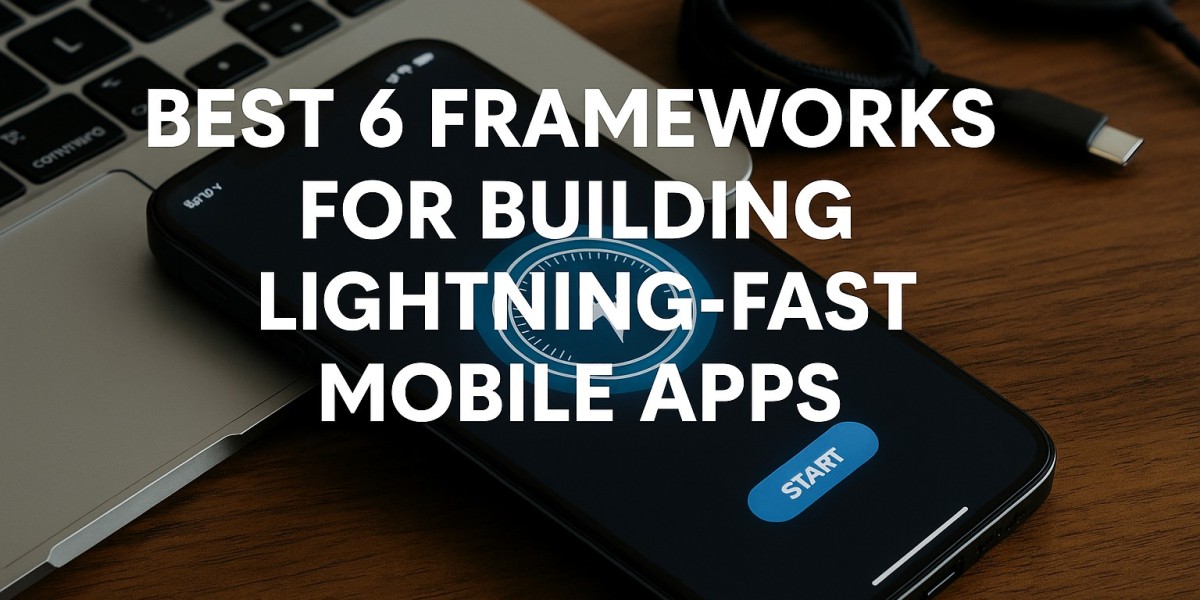In today's fast-paced digital world, users expect mobile applications to be lightning-fast, highly responsive, and deliver a seamless experience. Slow loading times or choppy performance can quickly lead to user frustration and uninstalls. Choosing the right framework is paramount for any Mobile App Development Agency aiming to build high-quality, performant applications that stand out in a crowded market.
Here are 6 top frameworks known for their ability to help build lightning-fast mobile apps:
1. Flutter
Developed by Google, Flutter has rapidly gained popularity for its ability to build natively compiled applications for mobile, web, and desktop from a single codebase.
Speed: Flutter achieves near-native performance because it compiles directly to ARM or Intel machine code (and JavaScript for web), rather than relying on a bridge or web views. It also uses its own high-performance rendering engine (Skia) to draw every pixel on the screen, ensuring consistent and smooth UI across all platforms.
Hot Reload: This feature allows developers to see changes applied almost instantly without losing the application's state, drastically speeding up the development and debugging process.
Rich Widget Library: Flutter's extensive set of pre-built, customizable widgets conforming to Material Design and Cupertino (iOS) guidelines enables the creation of visually appealing and high-performing UIs quickly.
2. React Native
Backed by Facebook (now Meta), React Native is an open-source JavaScript framework for building natively rendered mobile applications for iOS and Android.
Native UI Components: Unlike older hybrid frameworks, React Native renders actual native UI components, which contributes significantly to its performance and native look and feel.
Hot Reloading & Fast Refresh: Similar to Flutter, React Native offers hot reloading, allowing developers to make changes and see them reflected immediately, accelerating the iteration cycle.
Reusable Codebase: Its ability to reuse a single JavaScript codebase across both major platforms drastically reduces development time and effort, contributing to faster time-to-market for performant apps.
Large Ecosystem: A vast and active community, along with numerous third-party libraries and tools, provides ample resources for performance optimization and debugging.
3. Swift (for iOS Native Development)
For iOS-specific applications where absolute peak performance and tight integration with Apple's ecosystem are non-negotiable, Swift is the go-to choice.
Optimized Performance: Swift is designed for speed and efficiency, delivering exceptional native performance as it compiles directly to machine code, taking full advantage of iOS hardware.
Direct API Access: It provides direct, unbridled access to all native iOS APIs and features, allowing developers to optimize for specific platform capabilities that might be challenging or impossible with cross-platform tools.
SwiftUI: Apple's declarative UI framework, SwiftUI, simplifies UI development for all Apple platforms, enabling faster creation of visually rich and responsive interfaces with less code.
Xcode Integration: Seamless integration with Xcode, Apple's powerful IDE, provides comprehensive profiling and debugging tools to fine-tune app performance.
4. Kotlin (for Android Native Development)
For Android-specific applications that demand top-tier performance and deep integration with the Android platform, Kotlin is Google's preferred language.
Concise and Safe: Kotlin is a modern, statically typed language that reduces boilerplate code and offers null safety, leading to fewer crashes and more stable, performant applications.
Full Native Access: Like Swift for iOS, Kotlin provides full access to Android's native APIs and features, allowing for highly optimized performance tailored specifically for the Android ecosystem.
Kotlin Multiplatform Mobile (KMM): While primarily for native Android, KMM allows developers to share business logic (e.g., networking, data storage) across iOS and Android while still building native UIs for each, balancing performance with some code reusability.
Seamless Interoperability with Java: Kotlin is 100% interoperable with Java, allowing developers to leverage existing Java libraries and tools while gradually migrating to or integrating with Kotlin for new components.
5. Xamarin (.NET MAUI)
Acquired by Microsoft, Xamarin (now largely evolved into .NET Multi-platform App UI or .NET MAUI) allows developers to build cross-platform apps using C# and .NET.
Native Performance: Xamarin/MAUI compiles C# code into native binaries for each platform (iOS, Android, macOS, Windows), offering near-native performance and look-and-feel.
Shared Codebase (Logic): While UI can be platform-specific, a significant portion of the business logic can be shared across platforms, accelerating development and maintenance.
Microsoft Ecosystem: Strong integration with Visual Studio and the broader .NET ecosystem provides a robust development environment, especially beneficial for enterprises already invested in Microsoft technologies.
Hot Reload: Like Flutter and React Native, .NET MAUI offers Hot Reload for XAML (UI markup) and C# code changes, speeding up UI iteration and development.
6. Ionic
Ionic is an open-source framework for building hybrid apps using web technologies like HTML, CSS, and JavaScript, often integrating with Angular, React, or Vue.
Rapid Prototyping: Ionic's vast library of pre-designed UI components, combined with familiar web technologies, allows for incredibly fast prototyping and development.
Web View Optimization: While traditionally relying on web views, continuous advancements in WebView performance and Ionic's focus on hardware-accelerated transitions and touch-optimized gestures mean it can deliver surprisingly smooth experiences for many types of applications.
PWA Capabilities: Ionic is excellent for building Progressive Web Apps (PWAs), which offer app-like experiences directly from the web browser, providing a lightweight and fast way to engage users without an app store download.
Capacitor Integration: Ionic leverages Capacitor to access native device features, bridging the gap between web technologies and native capabilities, ensuring that performance-critical functionalities can utilize native APIs.
Choosing the best framework depends on the specific project requirements, target platforms, budget, and the expertise of the Mobile App Development Agency. However, these six frameworks consistently prove their ability to deliver lightning-fast mobile applications that meet the demanding performance expectations of today's users.













